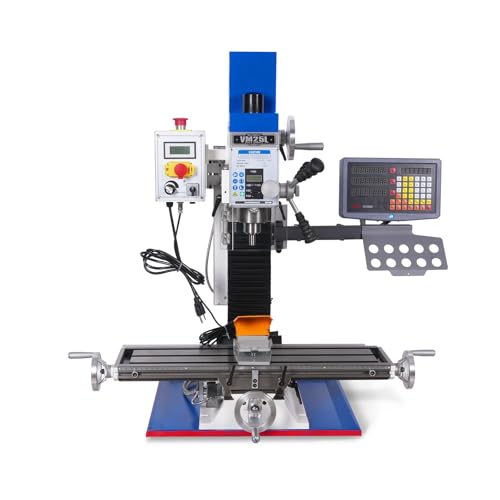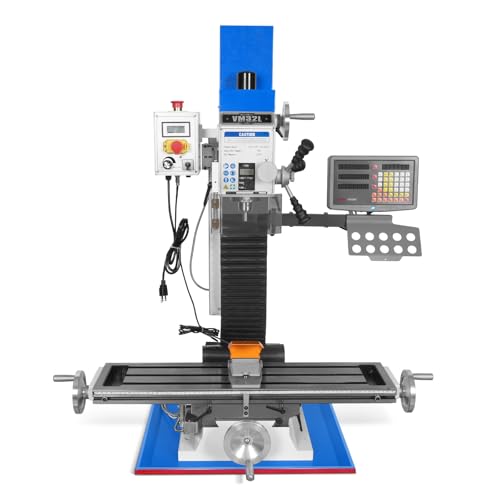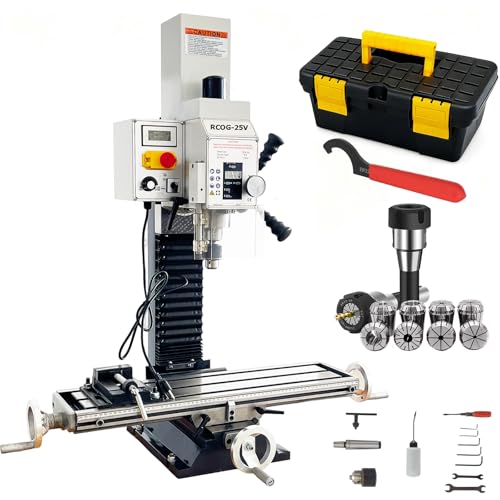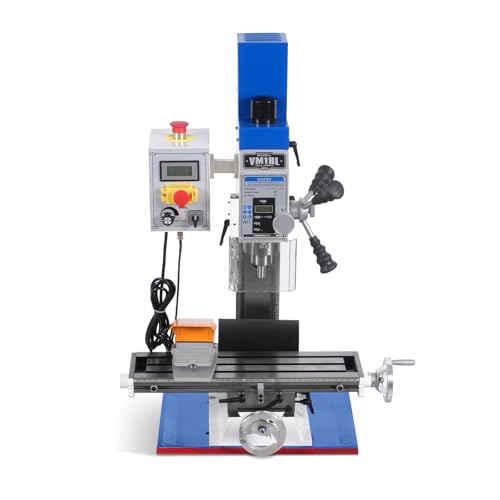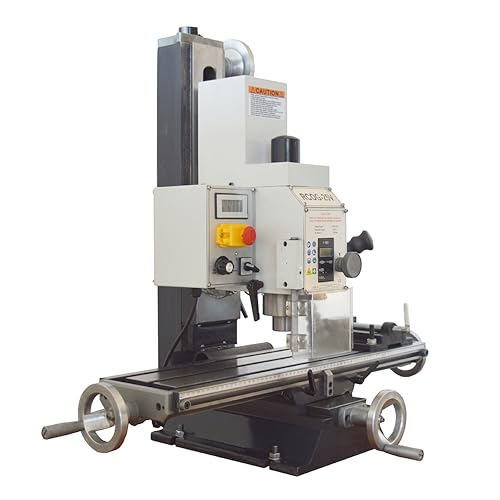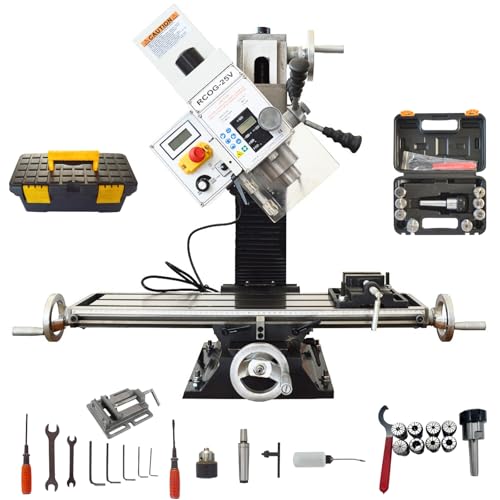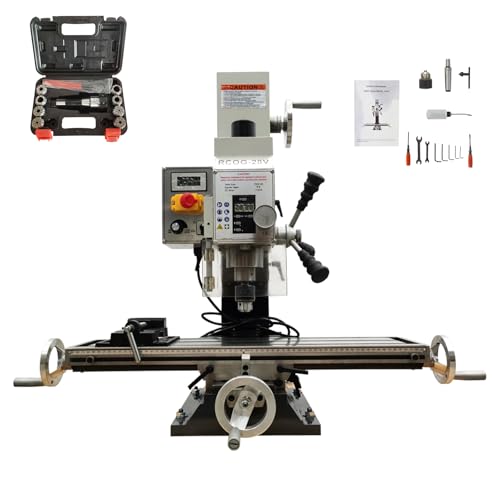If you like working with wood and are looking for a useful tool for this purpose, a benchtop milling machine is ideal. This device will allow you to easily face any carpentry or DIY operation, carrying out your projects in the best way, whether they are domestic or professional.
Not all wood milling machines are the same: each has its characteristics, and it is essential to know them if you want to get perfect results in all your work. For example, you have to take into account the power, the diameter of the cutters, the quality and the dimensions of the machine itself.
We had listed out some of the best milling machines that are present below.
- Variable speed operation ranges from 100 to 2000 RPM while the LED monitor displays the current spindle speed
- Spacious 27.6 by 6.3-inch work table combined with the 14.5-inch max distance between spindle and table provides ample room for...
- Table travels 19.75 inches along the X-axis and 6.5 inches along the Y-axis while the headstock travels 9.75 inches along the...
- Digital Z-axis DRO depth gauge showcases exact spindle travel for maximum precision
- Includes an R8 spindle taper, a 2.75-inch spindle travel, a pre-installed drill chuck (1/32 to 3/4 inch), fine-tune adjustment...
- 1.5 HP DC Brushless Motor: Low maintenance, smooth, and powerful motor for consistent operation.
- R8 Spindle Taper: Offers compatibility with a wide range of accessories, providing flexibility for various cutting tasks.
- 90° Head Tilt: Allows for versatile angled cutting and precise milling operations.
- Large Table Size: 7" x 27-1/2" for handling larger workpieces and providing ample space for more complex tasks.
- Variable Speed Range: 0-2500 RPM, ensuring optimal performance across a wide variety of materials.
- 3 5/8in. x 15 3/8in. work table with 8 5/8in. longitudinal travel and 4in. cross travel
- 7in. headstock travel
- Coarse down feed control for drilling
- Fine down feed control for accurate tool height setting
- 1/2in. drilling capacity, 5/8in. end mill capacity and 1 3/16in. face mill capacity
- Powerful 2 HP Brushless Motor: Delivers smooth, reliable power for heavy-duty tasks, with low maintenance and quiet operation.
- 3-Axis DRO System for Enhanced Precision: Provides real-time digital measurements on X, Y, and Z axes, ensuring accurate...
- R8 Spindle with Versatile Cutting Capacity: Offers wide tool compatibility, capable of drilling up to 1-1/4" (32mm), end milling...
- ±60° Tilting Head for Flexible Operations: Allows for angled cuts and complex milling with a precise head tilt for versatility...
- Generous Travel and Large Table Size: Features a 7-1/4" x 33" (180 x 700mm) table and large axis travel, enabling easy handling of...
- 1100W VARIABLE SPEED: The metalworking milling machine is equipped with a 1100W brushless spindle drive motor, providing high...
- SPACIOUS WORK SURFACE: The powerful mini milling drilling machine boasts a generous table size of 7''x27.56'' (180x700 mm) with a...
- MICRO-FEED PRECISION: This precision benchtop mill drill machine has micro-feed functionality,allowing for accuracy up to 0.01mm....
- ALL-METAL CONSTRUCTION: Durability and accuracy are crucial for the mini milling drilling machine.It utilizes an integrated...
- TILT FUNCTIONALITY: Featuring a tilting head that rotates up to 90° in either direction, this machine allows for exceptional...
- Designed for drilling, deep milling and face milling with variable speed control
- Drilling Capacity: 3/8" (10mm)
- End Mill Capacity: 3/8" (10mm)
- High-speed Steel 6-piece 4 Flute with 3/8" Shank set Included
- Includes 1/8", 3/16", 1/4", 5/16", 3/8" and 5/32" sizes
- Variable Spindle Speed for Flexibility: VM18L offers a variable spindle speed ranging from 0 to 2500 RPM, allowing users to easily...
- Enhanced Precision with R8 Spindle Taper: R8 spindle taper, the VM18L ensures high compatibility with a range of toolings,...
- Wide Cutting Capacity: outstanding cutting capabilities, including a 3/4" (18mm) drilling capacity and 2" (50mm) face milling...
- Flexible Head Tilt for Multi-Angle Operations:
- 60° head tilt allows for greater flexibility, enabling users to perform a variety of operations, including angled drilling,...
- [Widely Used] This mini drilling and milling machine is mainly used for slotting, plane milling, chamfering, milling groove,...
- [Use Conveniently] The benchtop mill machine is equipped with an LCD screen which can display the rotating speed and the drilling...
- [Process Various Workpieces] The benchtop drill machine's spindle speed is divided into two levels, 50-1125RPM and 100-2250RPM. By...
- [Stable Operation] The mini milling machine is powered by an 110V, 1100W pure copper brushless motor with overload and overheating...
- [User-Friendly Design] The mini drilling machine is equipped with an emergency stop switch with a waterproof lid and a forward and...
- 【Mill Drill Machine Parameters】Voltage:AC110V/60Hz,Motor power:1100W brushless motor,Max. drilling diameter:0.9"(25mm),Spindle...
- 【27.5" * 7.1" Working Table】The size of this milling machine's table is 27.5"x7.1"(700mm x 180mm),with a spindle stroke of...
- 【Precision Machining】The machine head can be tilted left and right within a 90-degree range.This operation can be performed by...
- 【Chuck Accessories】The drilling machine comes with a detachable milling chuck,and additionally,a set of MT3-ER32 milling chuck...
- 【Multi-functional Milling Drilling Machine】Possessing functions such as drilling,milling slots,and chamfering flat surfaces,it...
- Multiple Application: This milling working cross table machine is great for mounting on drilling machines for precise positioning....
- Premium Quality Structure: Built by heavy-duty cast iron material, which is anti-corrosion and rust resistance, angle milling...
- Highly Polishing & Stiffness: The compound slide table, with great hardness and stiffness, is high ground and not easy...
- 2 Axis 4 Ways Move: Handles with trapezoidal thread spindles is easy to adjust the directions. X-axis travel: 8.3 in / 210 mm,...
- Tightness Adjustment: Equipped with several quality bolts and nuts, you can easily adjust the tightness of this cross slide table....
- Advanced Grating Scales: Elevate precision with three-axis grating rulers, offering zero clearance, presets, dual measurement...
- Power Feed Efficiency: Axis X's power feed system ensures smooth forward/reverse operation and stepless speed control, reducing...
- High-Performance Brushless Motor: Unmatched reliability with a 1300W brushless motor featuring overload and overheat protection....
- Variable Speed Mastery: Seamlessly adjust spindle speeds from 50 to 2250 RPM, perfect for both high-speed drilling and meticulous...
- Versatile Tilt Head: Effortlessly achieve angled drilling and milling with a tilting head that rotates up to 90° in either...
- 【Purpose】- This is a MINI metal lathe/milling driven by a 12V safe DC transformer, which can be used for turning, drilling,...
- 【Processing】- It can be used to form and cut a wide variety of materials including wood, plastic and soft metals (pure copper...
- 【Application】- The machine defaults to use high speed motor. If you need a low speed motor, please contact us. Ideal for use...
- 【Durable】- Made of advanced aluminum alloy, durable and non-deformable for usage. The Milling is suitable for mini drill and...
- 【Main Parts of the Machine】- Main components, such as the headstock, intermediate block, connecting block, vice, sliders, and...
- High Precision Operation: Equipped with a workbench clamp that holds the workpiece firmly to the workbench for machining after...
- Adjustable Spindle Speed: The spindle speed is adjustable within the range of 50 to 2250 RPM. Properly adjusting the speed can...
- 1300W Brushless Motor: The brushless motor runs smooth and quiet, giving the drilling and milling machine a lot of stability. It...
- Machine Head 90° Tilt: Simply loosen the screw on the head and tilt it to the left or right without any other complicated...
- User-friendly Operation: With the spindle feed handle, you can manually control the drilling depth and automatically return to the...
Buyer Guide to Choose Benchtop Milling Machines
Wood milling machines are indispensable machines for those who love working with this material. They are devices that offer many possibilities.
In the following section, we present a purchase guide in which we will explain everything you need about milling machines. Read on to discover all the potential of these machines.
What Is a Milling Machine?
A wood milling machine is a machine that allows you to work wood by removing chips. The removal, the profiling and the cutting are carried out by the movement of a rotary tool with several wires called a cutter.
With milling, in general, it is possible to work various materials in addition to wood, such as steel, cast iron and synthetic metals.
The milling machines also allow for sanding and sharpening work. In traditional milling machines, the piece is moved to bring the parts to be machined closer to the blade, obtaining different shapes, from entirely flat surfaces to more complex ones.
Modern wood milling machines have computerized systems and are called “numerical control” (CNC).
Horizontal or vertical
The first decision that you will have to make when you find yourself buying a milling machine is whether to opt for a vertical or horizontal model, a choice that impacts both on the type of work you can perform and on the sale price.
Vertical models work by rotating around a vertical axis. This makes them particularly suitable for processes such as milling of grooves or in circles that would be impossible with other types of milling machines.
The horizontal ones, in fact, are formed by a base on which an upright is fixed which houses the drive head, the slides for moving the piece and the transmission mechanisms.
These models are best suited for mass production and, in the case of professional needs, it is possible to opt for computer-controlled models which, through digitized processes, guarantee the production of perfectly identical objects.
Entering the specific of the more professional models, there are many other types of milling machine: from the universal one to the planer one, from the copying one to the one for screws or gears.
In short, the choice is full, even if in the latter cases we are talking about products that are certainly not suitable for DIY.
Solid Structure
Typically, milling machines are tools that make the solidity of their structure one of the strengths. On the other hand, during their operation, they must be able to absorb all the vibrations generated by the processing without affecting the stability of the machine.
Even in the models of the best brand, the operation must be facilitated by the use of lubricant, which allows to reduce the heat generated by the tips and reduce their effort and wear.
To obtain exact work, it is essential that the milling machine has a mechanism with an indication of millimetres in order to adjust the milling depth correctly.
So as to obtain flawless machining and that have the fundamental precision in operations that do not allow an approximation. So choose a model that has a millimetre indication plate made directly from the metal and not glued.
Power and Convenience
It is quite easy to associate the power (expressed in horses) of a milling machine with its ductility. And in fact, it is so, because an appliance equipped with a powerful motor will be able to perform work on a wide range of materials, including the most resistant ones.
However, if you already know that you will need to operate exclusively on soft materials, you can safely focus on a less powerful and cheaper model.
Whichever milling machine you choose, however, it is good that it has the on / off switch at hand, if not directly on the handle. In this way, you can operate simply and also ensure a higher level of security.
Finally, the ease of use also passes through the comfort with which it is possible to change the various cutters as needed. Our advice is to opt for a model that allows its replacement without having to perform complicated operations.
For Very Demanding Hobbyists
The numbers of this power tool are the ones that most appeal to carpentry enthusiasts who are looking for a tool that can follow them well in their DIY works.
Without having too high demands, many users complain of some flaw in terms of cutting precision that cannot be adjusted to the thousandth of a millimetre.
Good the ability to work at different speeds, the nominal, therefore the idle turns, can be adjusted from a minimum of 11 thousand to 28 thousand per minute. The machine achieves these results with maximum electricity consumption of 1.4 kW—a remarkable performance.
But what I like most is that there are no voltage drops and that the power always remains constant based on the type of work being done, so do not worry if you have to face curves or chases that are particularly demanding in the design you are following on the wood.
Easy Replacement of Accessories
Milling machines can be tedious to use when tools for replacement are needed to replace pieces of a different calibre. Here it is nice to know that you can count on an insertion system facilitated and patented by Bosch that allows you to mount the copier in just a few steps.
The same applies to the replacement of the drills, which can be mounted on the integrated spindle and fixed with a spring locking system.
The ergonomic shape and the ability to adjust the thickness and type of tools to be connected at the start complete the picture of the right product.
The Extras that Never Fail
There is a guiding light that illuminates the work surface while continuing along the track. The screen that protects the view from the infiltration of dust is also handy. The machine itself is well insulated from the possibility of collecting dust, which would end up compromising its operation.
Do not miss the attachment for the extractor to use while working and therefore make the environment around free from slag and remains that are dispersed in the room.
The adjustment of the milling depth thickness is easily adjustable before starting the work and thus being able to proceed with precise grooves from one to ten millimetres.
How to Use a Milling Machine
Among the machine tools, the dream of DIY enthusiasts, there is the milling machine, a device that is used not only among professionals and which proves its presence in the hobby line of the best brands in the sector.
A necessary clarification to make at the opening is that the term cutter is often misused which, in reality, indicates the tools to be used according to the needs and not the machine itself.
The Description of The Milling Machine
Let’s try to describe in simple words and with a general character what a milling machine is. It consists of a motor connected to a spindle to which the cutter is fixed. The cutter operates in such a way as to perform a lateral cut, in order to erode the workpiece
The Movement
The milling machine moves on the surface of the piece and to do this, there are two possible ways: by moving the bench according to a two-axis system (X, Y) or by moving the tool head, always imagining a three-axis system (X, Y and Z).
In this case, the desk is fixed. In small workshops for hobbyists it is customary to use manual movement milling machines while for professional and industrial work, numerical control ones are preferred.
The Types of Milling Machines
There are two types of milling machines that stand out vertically and horizontally. The vertical milling machine, moving along the X and Y axes with the motor positioned on the vertical axis, called Z, can perform a combination of movements that allow you to make holes and boring.
The horizontal milling machine, on the other hand, while still having a flat platform, has the cutting unit placed on a lateral guide. In general, the horizontal milling machine is used to flatten the blocks of various materials or to make recesses, slots and continuous pockets.
The Types of Cutters
It is interesting, as well as useful, to know which types of cutters exist, or at least which are the most commonly used. The cylindrical cutter can be by flattening or by cutting.
In the first case, the cutting edges are located on the upper part and are used to make flat faces. In the second case, we find spiral-shaped blades placed along the entire length of the stem.
This cutter is used to smooth vertical walls evenly. Another type of cutter is the truncated cone cutter. It lends itself to various uses but is mainly used for finishes.
The spherical milling cutter is also used for finishing work and is useful when eliminating the so-called steps caused by the passage of large milling cutters usually used in ginning.


